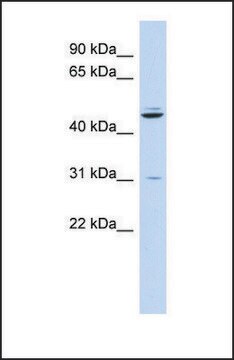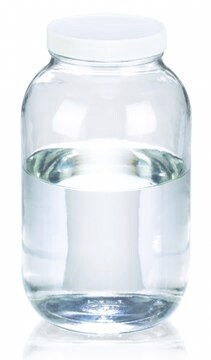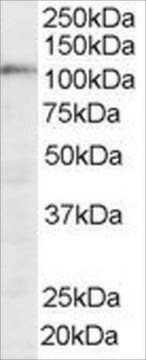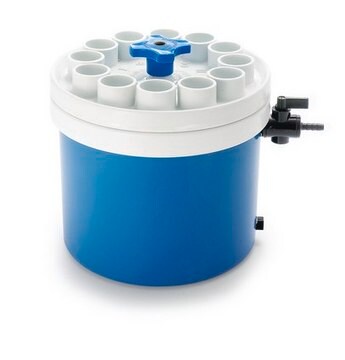ABC1431
Anti-HAF/SART1 Antibody
serum, from rabbit
Sinónimos:
U4/U6.U5 tri-snRNP-associated protein 1, Allergen Hom s 1, HAF, hSART-1, hSnu66, SART-1, Hypoxia-associated factor, SNU66 homolog, Squamous cell carcinoma antigen recognized by T-cells 1, U4/U6.U5 tri-snRNP-associated 110 kDa protein
About This Item
Productos recomendados
origen biológico
rabbit
Nivel de calidad
forma del anticuerpo
serum
tipo de anticuerpo
primary antibodies
clon
polyclonal
reactividad de especies
human, mouse
técnicas
ChIP: suitable
immunoprecipitation (IP): suitable
western blot: suitable
Nº de acceso NCBI
Nº de acceso UniProt
Condiciones de envío
ambient
modificación del objetivo postraduccional
unmodified
Información sobre el gen
human ... SART1(9092)
Descripción general
Especificidad
Inmunógeno
Aplicación
Immunoprecipitation Analysis: A representative lot immunoprecipitated HAF from human renal carcinoma ACHN cell lysate (Koh, M.Y. et al. (2015). Cancer Res. 75(2):316-329).
Western Blotting Analysis: Representative lots detected both endogenous and exogenously expressed HAF in various transfected human cancer cells, while a downregulated HAF was detected in cells co-transfected with HAF siRNA (Koh, M.Y. et al. (2015). Cancer Res. 75(2):316-329; Koh, M.Y. et al. (2011). Cancer Res. 71(11):4015-4027; Koh, M.Y., et al. (2008). Mol. Cell. Biol. 28(23):7081-7095).
Western Blotting Analysis: A representative lot detected HAP in HIF-1 immunoprecipitate from A549, HCT-116, and HT-29 xenografts (Koh, M.Y., et al. (2008). Mol. Cell. Biol. 28(23):7081-7095).
Apoptosis & Cancer
Calidad
Western Blotting Analysis: A 1:2,000 dilution of this antiserum detected HAF/SART1 in 10 µg of U2OS nuclear extract.
Descripción de destino
Forma física
Almacenamiento y estabilidad
Handling Recommendations: Upon receipt and prior to removing the cap, centrifuge the vial and gently mix the solution. Aliquot into microcentrifuge tubes and store at -20°C. Avoid repeated freeze/thaw cycles, which may damage IgG and affect product performance.
Otras notas
Cláusula de descargo de responsabilidad
¿No encuentra el producto adecuado?
Pruebe nuestro Herramienta de selección de productos.
Código de clase de almacenamiento
12 - Non Combustible Liquids
Clase de riesgo para el agua (WGK)
WGK 1
Punto de inflamabilidad (°F)
Not applicable
Punto de inflamabilidad (°C)
Not applicable
Certificados de análisis (COA)
Busque Certificados de análisis (COA) introduciendo el número de lote del producto. Los números de lote se encuentran en la etiqueta del producto después de las palabras «Lot» o «Batch»
¿Ya tiene este producto?
Encuentre la documentación para los productos que ha comprado recientemente en la Biblioteca de documentos.
Nuestro equipo de científicos tiene experiencia en todas las áreas de investigación: Ciencias de la vida, Ciencia de los materiales, Síntesis química, Cromatografía, Analítica y muchas otras.
Póngase en contacto con el Servicio técnico






